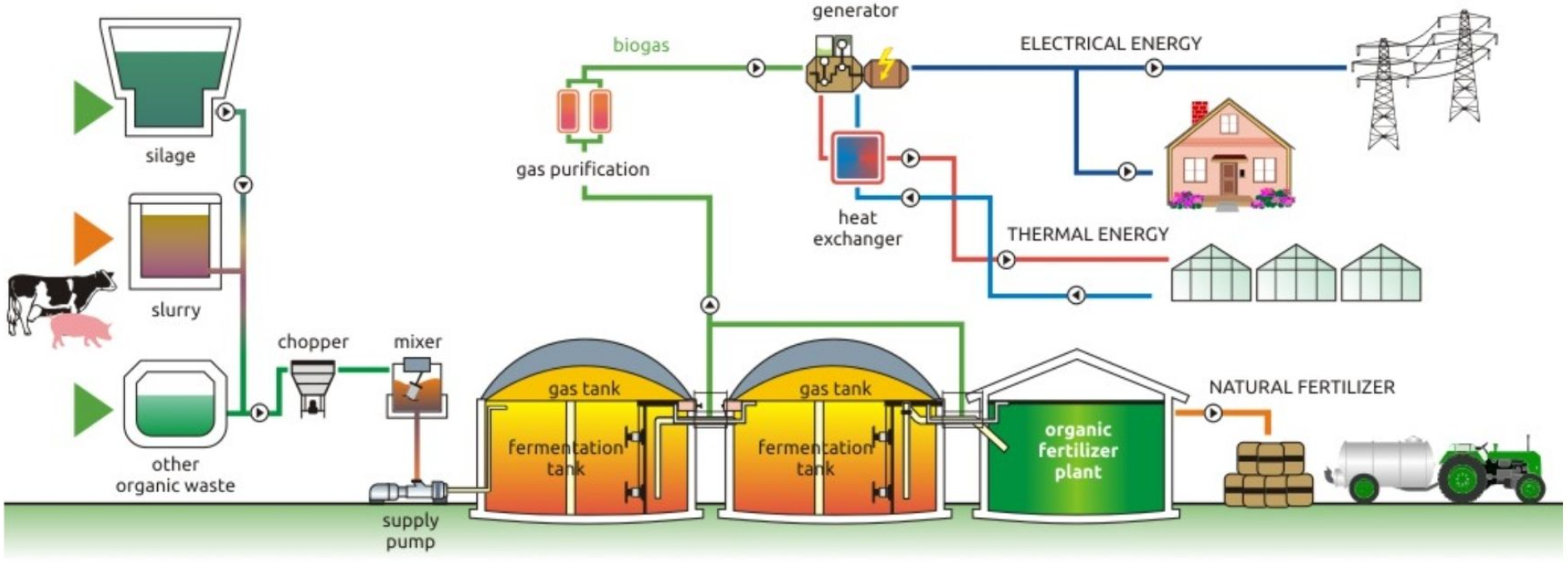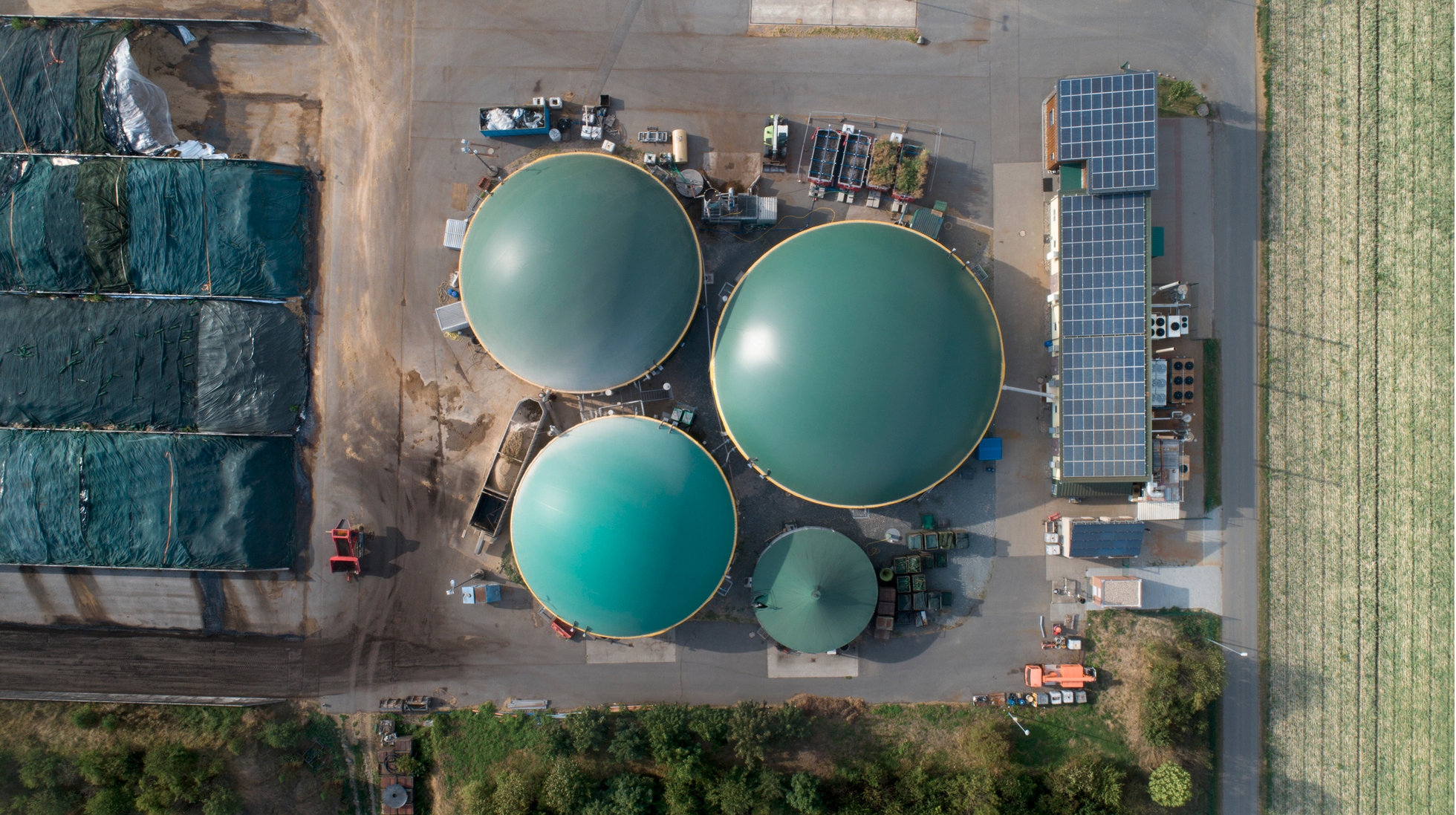Introduction[1]
In 2019, around 132,000 small, medium or large-scale digesters were operating globally in biogas plants that employed over 344,000 people directly or indirectly. How do these facilities work?
Biogas plants follow an automatic, straightforward process created to replicate the natural process of anaerobic digestion in an artificial environment, making biogas production simple and carbon neutral.
What is a biogas plant?[2]
Biogas plants are known by several names. Anaerobic digester (AD) plants, waste to energy plants, biogas generators and biogas digesters are just a few. However, whatever they get called, and whatever size they are, they all fulfil the same function – converting organic material or biomass into useful biogas.
Utilising feedstocks such as purpose grown crops, food waste, other plant material, municipal waste, manure, and wastewater biosolids, bacteria in the digester turn this organic matter into methane and carbon dioxide – the main components of biogas.
The biogas created can then be converted into renewable electricity via a combustion engine that powers a generator, to be exported to the National Electricity Grid. Or it can undergo a cleaning process to remove the carbon dioxide, moisture, hydrogen sulphide and any particulates or impurities to create high-quality biomethane.
Once this process has taken place, the biomethane can be exported to the National Gas Grid.
How do anaerobic digesters work?[2]
As the name suggests, anaerobic digestion involves the breaking down of organic matter in a closed system without the presence of oxygen.
Methanogenic organisms digest the organic feedstock to produce biogas as well as a digestate rich in nitrogen, potassium and phosphorus, which is often used by farmers as a fertiliser.
The digestion process involves four different stages to convert the feedstock into biogas, including:
- Hydrolysis – complex organic matter such as proteins, carbohydrates and fats are broken down by bacterial enzymes into their constituent parts, such as sugars, fatty acids, and amino acids.
- Acidogenesis – various fermentation reactions convert larger molecules into organic acids, alcohols, ammonia, carbon dioxide, hydrogen and hydrogen sulphide.
- Acetogenesis – the fermented products are then oxidised into simpler forms such as acetate and carbon dioxide.
- Methanogenesis – finally, Archaea (single cell organisms) convert hydrogen and acetic acid into methane and carbon dioxide.
Of these, the final two processes have the most influence on the quality of the biogas produced because these are responsible for the ratio of methane to carbon dioxide. Different feedstocks also significantly affect the concentration of methane created.
Typically, biogas is 50 per cent to 75 per cent methane, with the rest being made up of CO2, water vapour and some other assorted gases in much smaller concentrations. However, scrubbing can produce biomethane of more than 98 per cent methane concentrate, which can then be exported to the National Gas Grid.
Components of a Biogas Plant[1]
A biogas plant has three major components that make the biogas production process possible:
- a reception area
- a digester (or fermentation tank)
- a gas holder
Figure 1: Diagram of Biogas Production Plant[3]

The reception area is where the raw materials arrive and are prepared for anaerobic digestion. Each type of biomass has a different fermentation process, so the overall length of the biogas production process varies depending on the raw materials used, and it isn’t uncommon to use pre-treatments in industrial biogas plants to accelerate fermentation and increase the production of biogas.
Some of the most popular biomass choices are crop residues, municipal and industrial sewage, agricultural material, livestock manures, seaweed, food-processing, and paper wastes, but the list of raw materials used is significantly longer.
The digester is an air-tight, waterproof container with a mean of entry with a mean of entry for the biomass. Here, you introduce the raw materials to be transformed into energy. Then, agitators shift the biomass periodically to free the gases and prevent the formation of layers. The digester also includes a pipe that enables the digestate to be removed after the fermentation is over.
The gas holder is an airproof container, preferably made in steel, that collects the gas generated during fermentation. It’s provided with a gas outlet that permits the biogas to come out of the system and produce energy and heat.
Depending on the quantity of waste you want to eliminate from the environment or the volume of biogas you need to produce, a plant might have more than one digester and gas holders.
How does a Biogas Plant work?[1]
While some steps could vary with each biogas plant, most facilities use the same process to produce biogas.
Step 1 – Pre-treatment and filling the digester
Multiple types of organic matter, called substrates, go into the digester. Some substrates can be liquid manure, renewable raw materials (such as corn or grass), or waste produced by the food industry. Some of them may need to be stored in cement containers and pre-treated before entering the air-tight tank. One plant can include several digesters, depending on its size.
Step 2 – The fermentation process
The substrates are heated to various temperatures inside the fermenter, and a series of microorganisms start breaking down the organic matter in the absence of light and oxygen. During the process, the organic matter is shifted to prevent layers from forming at the top and bottom of the tank.
Step 3 – Producing biogas
As a result of the fermentation, biogas with methane as the main ingredient is produced inside the fermenters. At this stage of the process, the gas includes, besides methane and carbon dioxide, water and hydrogen sulfide—which is one of the main reasons containers should be made in steel, known to withstand the effects of the gas for long periods.
Step 4 – Pulling out the residues
After fermentation, the residues called digestate are pulled out of the tank to be used as environment-friendly, high-quality fertilizer. This way, the biogas production process becomes a zero-waste system of eliminating garbage from landfills while providing a solution for better crops at the same time.
Step 5 – Eliminating impurities
The biogas goes through a cleanup process, in which water, hydrogen sulfide, and impurities are removed to produce biomethane that can further be used to generate energy and heat. The biogas is permanently monitored to ensure the quality of the final product.
1. HOMEBIOGAS, WHAT IS A BIOGAS PLANT AND HOW DOES IT WORK?
2. Birch Solutions, 9 Jul 2021, How Much does it Cost to Build a Biogas Plant?
3. Amapex smart enviro treatments, 15 Sep 2020, How to increase biogas efficiency?










